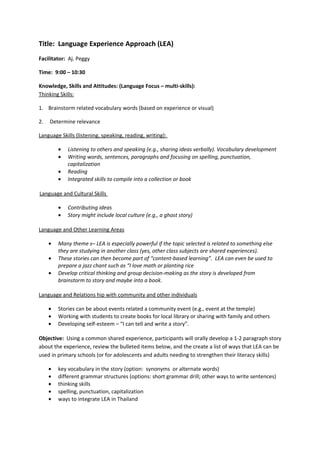
Language experience approach .msw03
- 1. Title: Language Experience Approach (LEA) Facilitator: Aj. Peggy Time: 9:00 – 10:30 Knowledge, Skills and Attitudes: (Language Focus – multi-skills): Thinking Skills: 1. Brainstorm related vocabulary words (based on experience or visual) 2. Determine relevance Language Skills (listening, speaking, reading, writing): • Listening to others and speaking (e.g., sharing ideas verbally). Vocabulary development • Writing words, sentences, paragraphs and focusing on spelling, punctuation, capitalization • Reading • Integrated skills to compile into a collection or book Language and Cultural Skills • Contributing ideas • Story might include local culture (e.g., a ghost story) Language and Other Learning Areas • Many theme s– LEA is especially powerful if the topic selected is related to something else they are studying in another class (yes, other class subjects are shared experiences). • These stories can then become part of “content-based learning”. LEA can even be used to prepare a jazz chant such as “I love math or planting rice • Develop critical thinking and group decision-making as the story is developed from brainstorm to story and maybe into a book. Language and Relations hip with community and other individuals • Stories can be about events related a community event (e.g., event at the temple) • Working with students to create books for local library or sharing with family and others • Developing self-esteem – “I can tell and write a story”. Objective: Using a common shared experience, participants will orally develop a 1-2 paragraph story about the experience, review the bulleted items below, and the create a list of ways that LEA can be used in primary schools (or for adolescents and adults needing to strengthen their literacy skills) • key vocabulary in the story (option: synonyms or alternate words) • different grammar structures (options: short grammar drill; other ways to write sentences) • thinking skills • spelling, punctuation, capitalization • ways to integrate LEA in Thailand
- 2. Materials: A shared experience (or use pictures to generate a story). Session Plan: 1. Motivation (P) 1.1 Ask everyone to make themselves feel comfortable. And then close their eyes (aka warm-up) (okay if they prefer open eyed) to think back to the few days before their left their home and what they did to prepare to come to the workshop for 5 days in (P = Prime the Bangkok). pump) * How did you feel? * What did you do? Preparation * How did you travel – how was it finding the hotel, seeing people, settling in? 1.2 Okay… open your eyes. Everyone take about 3 minutes to write down your own thoughts. Words okay – no need for sentences, don’t worry about spelling. 2. Presentation (P) 2.1 Begin to elicit words related to their preparation and travel (content or learning/teaching 2.2 Cluster types of vocabulary/phrases strategy is * feelings +/-; shared) * transportation, time/length; * tasks related to work -- travel – home – family/friends – social life, etc. (P = Present) 2.3 Brainstorm ideas for organizing our story – beginning, middle, end, title 3. Practice (P) Consider doing as a “fish bowl” with some participants (playing with the 3.1 Elicit the first sentence and write it on the board, paper, or screen. Continue new technique or developing the story sentence by sentence. Ask participants if they agree or want to learning strategy; make any changes (spelling, word order, grammar, punctuation, different word how does this choice, etc.) as you go along OR wait till end. work?) 3.2 Continue eliciting sentences (taking suggestions as story develops) until the (P= Practice) group thinks their story is done. Make sure it has a title (yes, you can put a title on at the end or in the beginning or middle). 3.3 Have everyone read the story aloud to make sure it sounds right. Elicit any changes from the group. 4. Application (P) 4.1. So What? What’s next? Have pairs/trios work together to develop 4- 5 (how can trainers different exercises that can be used with this story. Put them on flipchart paper. or students use (And consider including group members’ names) the language or 4.1.1 practice spelling ideas?) 4.1.2 focus on pronunciation 4.1.3 expand vocabulary (synonyms/antonyms; definitions; use each new word in a (P= Product or new sentence) Produce) 4.1.4 develop comprehension questions (Yes/No, True/False, Wh- questions{who, what, when , where, why, how} ; focus on developing direct questions from the text and inferential questions from the context 4.1.5 play game 4.1.6 illustrate the story to engage multiple intelligences and special skills 4.2. Post activity flipcharts on the walls. Do a “gallery walk” so that everyone can see the similarities and varieties. Allow folks to take notes as they see the creativity on the walls. 4.3 Some ideas for training and for use in classroom /school /community expansion 4.3.1 Vote for best activities using post it notes 4.3.2 After students stories have been edited, have them compile them into books of short stories. If possible, do some simple binding and illustrations.
- 3. 4.3.3 Books with or without exercises can be used for classroom or school library. Older students can be readers for younger students. Children can take books home for parents and read to their parents in English and explain their stories.